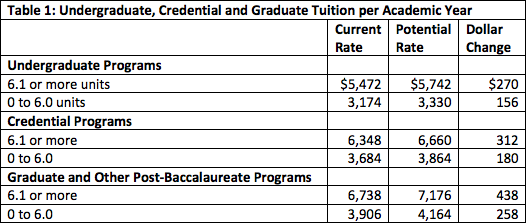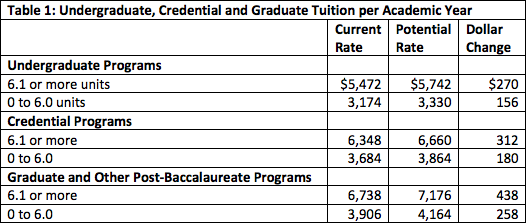A proposal released this month by California State University Chancellor Timothy White includes every college student’s least favorite words: A tuition increase.
The chancellor is proposing an increase of $270 per student, an increase of 4.9 percent, to take effect during the 2017-18 school year.
The tuition hike is needed for a number of reasons, the chancellor explained in a recently released 13-page document.
For approximately 20 years, the number of students enrolled in the California State University system has increased, while state funding has decreased. Since the universities are funded by allocated tax revenue and tuition, when tax revenue goes down, tuition has to increase to ensure that the Cal State system can still operate, he said.
“The CSU has two funding sources: the state general fund, provided by the state Legislature and governor, and system-wide tuition, paid by students and their families,” said California State University spokesperson Elizabeth Chapin. “Every year, the CSU requests adequate funding from the state as part of the budget cycle. As of right now, there is a $169 million gap between the CSU’s preliminary budget plan for 2017-18 and the state’s funding plan.”
The CSU system only received the funding it requested for one of those years. Altogether, this means the CSU system did not receive more than $400 million that it needed and requested over the last four years.
The $270-per-student increase was calculated to create more than $70 million in revenue for the university system. If the Board of Trustees approves the tuition increase at its January meeting, the increase would go into effect for the 2017-2018 school year.
“If the state does not fund the gap, the CSU may need to consider difficult options including reducing programs and services or an increase in tuition,” Chapin said.
The tuition increase proposal also includes a proposed budget for the year, which totals estimates of what the CSU system would spend on its expenses and how much revenue it would receive.
According to the table that outlines all of the costs and income for the year, the CSU systemneeds to increase revenue by almost $170 million in order to pay for all expenses.
In many cases, however, the increased tuition costs may not even affect students. The tuition increase is promised to not affect financial aid, both on the state and federal level. According to the proposal, almost 80 percent of CSU students receive financial aid, and more than 60 percent of students have their tuition paid for entirely by financial aid.
According to the proposal, the California State University system has three possible options to maintain their budget: receive more money from the state, increase tuition or reduce services offered.
The first option is cited as the most ideal, but the state budget will not be finalized until June, leaving the CSU system uncertain as to how much funding it will receive until then. Conversely, the third option is least ideal because it would ultimately hinder students’ ability to graduate on time.
“The first and highest priority to close the gap is to advocate in Sacramento for increased state funding,” said Chapin. “CSU leaders, students, and stakeholders will work with the governor and state legislative leaders to advocate for increased funding for the CSU to ensure that the university has the resources needed to continue to provide affordable, high-quality degrees to California students.”
Individual CSU campuses will have to assess how the system-wide tuition increase will affect their school and students.
“We are currently gathering input on the proposals, and students are encouraged to express their views through Associated Students,” said Nicolas Grizzle, news and information coordinator, before referring to the CSU system’s statement.
Students are concerned about what an increase in their tuition will do to their financial state both now and in the future.
“I transferred from Santa Rosa Junior College in the fall semester of 2015,” said senior communications major Kelsey Taylor. “After my two years at Sonoma, I will owe roughly $28,000 plus interest that has accumulated over time. With that sum of money hanging over my head, I am so grateful that I did not spend any more time at Sonoma State. That is not to say that I have not enjoyed my time at SSU, but I cannot even begin to imagine graduating with any more debt than I already have. This semester I am taking 19 units just to be absolutely sure that I can graduate in spring 2017.”





![[Both photos courtesy of sonoma.edu]
Ming-Ting Mike Lee stepped in as the new SSU president following Sakakis resignation in July 2022](https://sonomastatestar.com/wp-content/uploads/2024/04/CC4520AB-22A7-41B2-9F6F-2A2D5F76A28C-1200x1200.jpeg)



























